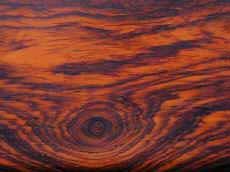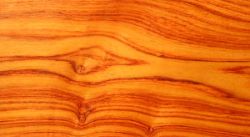Materials We Use
Jacoby Custom Cues Materials
 |
ABALONE belongs to the phylum Mollusca, a group which includes clams, scallops, sea slugs, octopuses and squid. They are best known for their beautifully formed shells because of their inner, iridescent layer. Abalone is farmed in California, Japan, China, Korea, Taiwan, Thailand, Australia, New Zealand, Chile and South Africa. |
 |
AMBOYNA BURL is from the Curly Narra or Red Narra tree which grow in the Phillippines and Papua New Guinea. The heartwood varies from light yellow, through golden brown to brick red in color. The grain in Amboyna is wavy, interlocked or crossed and these irregularities give rise to mottle, fiddleback, ripple and curly effects of figure. The more red the Amboyna wood, the heavier it is. |
 |
AZURITE MALACHITE is found in Australia, Chile, France, Mexico, Morocco, Nambia, the southwestern USA, and Zaire. Azurite offten occurs with malachite in areas with copper deposits. Sources claim that the name azurite is derived from the Persian word lazhward or from the Arabic word azul, both of which mean blue. For thousands of years this stone has been used in jewelry and ornamental objects. During the Middle Ages and Renaissance it was ground into pigment for use in paint and eye shadow. Azurite was sacred to the Egyptians who believed it was an aid to spiritual communication. Many believe that this stone helps to reduce anger and to increase psychic awareness. It is also thought to reduce abnormal cell growth, promote wisdom, and is used as an aid to relieve the pain of rheumatism. |
 |
BIRDSEYE MAPLE is found in North America. The birds eye forms around the log due to ’sleeping bud growth’, this shows as small dots in the wood. Birdseye develop when the tree grows on barren and rocky ground. The amount of eyes in the wood varies from piece to piece. When a large amount of eyes are present it is considered high figured. |
 |
BLACK & WHITE EBONY is a rare and unusual specie of the ebony family mainly found in Laos. This heartwood is creamy off white with a striking contrast of distinct and irregular black veins. |
 |
BLACK PALM is native to Southeast Asia. The trees can reach tremendous heights of 100 feet or more, and are so hearty that they sometimes live for more than 100 years. Black Palm is hard, dense, and has distinctive stringy streaks embedded in the wood that make it somewhat difficult to work with. |
 |
BLOODY BASIN JASPER is native to Arizona, named for the region (Bloody Basin) from which it is mined. The jasper is prized for its' deep crimson tone with jet black veins. |
 |
BOCOTE, also known as "Mexican Rosewood," is indigenous to Central America, South America, and Mexico. It is sought for its great beauty and ease of working. Bocote is a particularly fine, beautiful wood, with colors varying from light to golden brown and variegated irregular markings. Bocote is a lustrous wood, with medium and uniform texture and straight or shallowly interlocked grain. |
 |
BOXELDER BURL is a maple species found in the Eastern United States and South Central Canada. Boxelder displays light colors throughout its grain with variations ranging from cream to light brown. Swirling grain patterns and sharp, irregular changes are the hallmark of the boxelder burl. This wood can be impregnated with dye to lend itself to an even wider color pallet. The colors shown are brown, green, gray, blue and red. |
 |
BUCKEYE BURL is a tree that grows predominately in Ohio and other parts of the Ohio Valley. The common name "Buckeye" is said to have derived from American Indians in the area that observed that the tree's seeds looked very similar to the eyes of the male deer in the region. In the United States buckeye is found from the Appalachians of Pennsylvania, Virginia, and North Carolina westward to Kansas, Oklahoma, and Texas. Color ranges from bright yellow to cream with streaks of black, blue, green & white throughout. The buckeye tree is medium sized, reaching less than 100 feet with a trunk diameter of up to three feet. Its wood is relatively light in color. When burl is part of its composition, dark areas are also prominent. |
 |
BUFFALO TURQUOISE is found in only in one mine worldwide, the Dry Creek Mine in Nevada. The mine is located on the Shoshone Indian Reservation near Battle Mountain. It is said that its name comes from Native Americans in the area, who believe that the stone "is as rare as a white buffalo." Buffalo turquoise is white with black webbing running through it. It is believed to form like "normal turquoise," with the exception of the absence of copper (which makes turquoise blue), iron (which makes it green), or zinc (which leads to yellow-green turquoise). |
 |
COCOBOLO is a member of the Rosewood family. It grows in the drier uplands on the Pacific side of Mexico down to Panama. This hardwood color varies from rich red to a variegated appearance of yellow, orange and red with black streaks. The grain is irregular but has a fine uniform texture. |
 |
GABON EBONY (diospyros crassiflora) is said to be "the blackest wood in the world," although it does sometimes contain brown highlights. The diospyros crassiflora trees that grow in Gabon Africa can grow to about 50 feet in height and two feet in diameter, but these are very old trees. Most of the trees available nowadays are considerably smalleralthough they are just as hard, heavy, and dense. An interesting fact about ebony is the Ancient Greeks referred to black ebony as the "fruit of the gods," which is the translation of the genus name "Diospyros" (taken from the Ancient Greek for date-plum). |
 |
ELFORYN is a high-grade ivory substitute material that has a high mineral content. The aim was to promote environmental sustainability and develop a material that would as closely as possible resemble ivory. This material is much more stable than ivory and will not change color over time. Elforyn is chalk resistant and even fluorescent under a black light. |
 |
HOLLY is found in UK Europe, Western Asia, the USA, Guinea and Brazil. The further north the tree is grown the whiter the wood will remain. Fine-grained and nearly devoid of figure, this moderately expensive wood is used mostly for small objects. It is sometimes reffered to as "poor man's ivory" due to its lesser price, compared to ivory, while still getting the same white appearance. The tree is slow-growing and usually quite small, so the wood is rare, particuarly in any substantial size, and it is likely to have knots which further reduces the sizes available for some applications. The tree has to be cut in winter and put into a kiln almost immediately and dried carefully or the wood will develop serious blue-stain which really ruins the white color that is this wood's claim to fame. |
 |
IVORY is a hard, smooth, yellowish-white substance composed primarily of dentin that forms the tusks of elephants. The ivory used is antique ivory that is legally purchased from museums or private collections, all within the United States. An affidavit of origin is available, attesting to the legel status of the ivory, upon request. To learn more about the laws on ivory please see the Amercian Cuemakers Association website. Also note that ivory is a beautiful material but it is in its nature to yellow over time as well as crack despite how it is installed. Proper storage and care adds to the longevity and quality of ivory but will not necassarily stop the course of nature. |
 |
KINGWOOD, also called “Violetwood”, found in Brazil is light to dark violet-brown with lighter and darker stripes with a bright luster and fine texture. French kings in centuries past reportedly favored this wood for their furniture; thus the name. |
 |
LACEWOOD from South America (Brazil) and Australia is pink to light reddish brown, and is figured with a distinct small lacelike pattern. Grain is straight with a fine to medium texture. A similar piece of material is leopardwood. |
 |
LAPIS, also known as lapis lazuli, is relatively abundant and affordable today, in ancient times, lapis was a rarity as mining was an arduous procedure done solely in the far reaches of northern Afghanistan. Highly prized, lapis imported from Afghanistan was carved into figurines, jewelry and talismans. The ancient Egyptians strongly believed lapis had many healing and spiritual powers. A lapis scarab was often buried with the dead as it was believed that lapis would protect them in the afterlife. Lapis was used more than any other stone in carvings of the third eye and was frequently adorned with gold. To the ancient Egyptians, lapis represented truth and was directly connected to the gods. The lapis shown is dark blue, denim blue and purple. |
 |
LEOPARDWOOD is from South American and has an appearance very similar to lacewood. A difference between the two is leopardwood is darker brown in color and is harder and heavier and with a noticibly finer texture. Both types of wood are mostly know for their fasinating appearance. When cut correctly each piece shows many cross sections of cells distributed evenly across the wood. |
 |
MALACHITE can be found in Zaire, USSR, Germany, France, Chile, Australia, Arizona and New Mexico/USA. Malachite is a popular stone which has light and dark green banded areas or webbing. Folklore claims it is the guardian stone of travelers. It promotes inner peace and hope, provides protection and security. |
 |
MAPLE BURL is often found on big leaf maples native to the Pacific Northwest. Maple burl is created by an unusual growth on trees that results in a highly figured piece of wood. Maple burl is often darker in color than maple wood, yellow ochre to brown, with many whorls and patterns and an uneven, rough edge. |
 |
MOTHER OF PEARL, also called nacre, is an iridescent layer of material which forms the shell lining of many mollusks. Mollusks create mother of pearl to protect themselves. Like other substances found in nature, mother of pearl develops irregularities as it forms. As a result, every piece of mother of pearl jewelry or inlay is slightly different. These irregularities often form in the mother of pearl as a result of irritation. If the irritation is extensive enough, the mollusk will form a large bump, that is actually a pearl. Only the outer layer of the pearl is covered in mother of pearl. |
 |
OLIVEWOOD is from Bethlehem. The olive tree is native to the Holy Land where it has been cultivated since ancient times. According to historians, the first olive groves took root in the Holy Land and along the coast of the eastern Mediterranean around 4,000 B.C. The olive tree is a slow growing tree which fills out during the first 7 years of it's life. Growing to heights ranging from 10 to 40 feet. Reaching the age of 200 the trunk disappears, shoots develop at the base of the trunk which eventually grow into a new tree, hence the reputation as the immortal tree. Olivewood is brown to rich greenish brown in color, streaked with dark brown lines. Sapwood is creamy yellow or gold color and is often intrerlaced with dark stripes. Very nice contrast. The figure ranges from straight to wavy. What makes this hardwood so unique is the extraordinary grain pattern of each individual piece. |
 |
Padauk, also known as Mutui, Ngula and Bosulu, is native to Central Africa. It is a vivid reddish-orange, but it changes to bright red or coral pink with dark streaks. |
 |
PINK IVORY is from Mozambique, Zimbabwe and South Africa and scattering in other parts of southern Africa. Pink Ivory wood, a sacred wood of Zulu chiefs in Southern Africa, has long been treasured as a rare wood. At one time, it was said to be rarer than diamonds. The grain is straight to irregular, while the texture is very fine. It is varying in color from pink to red, while the sapwood is almost white, and the pink heartwood, after long exposure, tends to become orange-colored. |
 |
PURPLEHEART includes species in tropical regions of Central America and South America. Generally straight grained, sometimes interlocked, with a fine even texture. It is a vibrant purple heartwood that turns to dark-purplish brown with exposure to light. |
 |
RED PALM is found in Myanmar. Red Palm is hard and dense with heartwood that is light yellow, with distinguishing red strings. |
 |
REDHEART is native to Mexico/Central America. The bright red background of Redheart is host to a number of very interesting streaks and closed knots. It is smooth and tight grained. |
 |
SPAULTED MAPLE is not a particular species of maple, but rather a figure of maple. Spalting, or the coloration of wood by fungi, is a natural phenomenon that occurs as fungi invades wood and initiates the decay process. This process creates unique coloration and patterns in the wood. Usually straight grained but sometimes curly or wavy with variations producing birds-eye or quilted patterns. Fine brown lines give an attractive character through the wood. To stop the decaying process the wood is stabilized. |
 |
THUYA BURL is indigenous to the hot, dry region of the western Mediterranean, thuya burls actually grow underground on the roots of Tetraclinis articulata trees. The color may very from deep reddish to bronze to tan. The black spots may be sparse or more packed together. |
 |
TULIPWOOD is from Tropical South America, especially Northeast Brazil. Tulipwood has irregular streaks of yellow, rose and red or violet on a cream to straw colored background. An interesting fact about tulipwood is the fragrant scent reminiscent of flowers when the wood is cut. |
 |
WHITE OAK wood is found in North America. White oak matures at 75 feet and under ideal conditions can reach 100 feet tall. White Oak wood is beige to creamy tan and it has a fine texture. |
 |
YELLOW HEART originates from the lower Amazon (Brazil). This heartwood is bright yellow in color throughout the wood with a fine straight grain. |
 |
ZEBRAWOOD is from West Africa. They are an equatorial tree of medium to large size, gregarious, commonly growing in pure strands along riverbanks. Can grow to heights of 150 feet with trunk diameters of 4 to 5 feet. When cut it gives off an unpleasant aroma which disappears as it dries.Zebrawood heartwood is a light golden-yellow with narrow veining or streaks of dark brown to almost black, giving the quartered surfaces a zebra-stripe appearance. |

